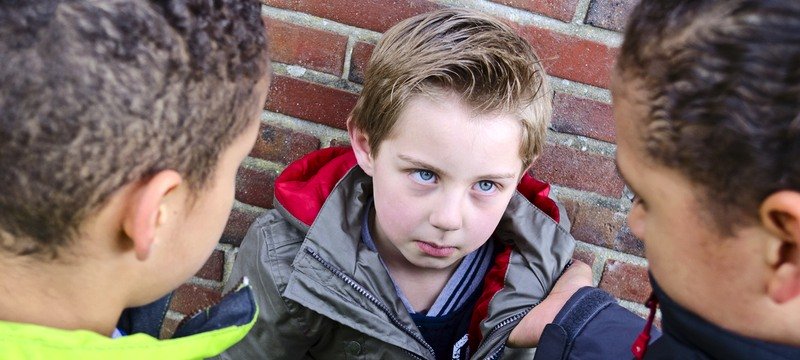Bullying is an inappropriate, disturbing behavior that often happens at school. It involves using force, making threats, spreading rumors, attacking someone physically or verbally, or ostracizing someone from the groups.
Millions and millions of students are victims of bullying each year. The sad part is that 6 out of 10 teachers doesn’t see anything wrong with bullying and will rarely take actions about it.
Bullying doesn’t happen only in school. It happens everywhere and worse comes to worst. It happens via internet, which we call cyber bullying. For example, a bully will upload a photo of someone with the embarrassing edited version, and make it the laughing stock in social networking sites.
Here are some things you should know about bullying:
1.
The targets of bullying usually have insecurities.
2.
Bullying is the main reason why most people try to fit into the distorted image of perfect society. It is the reason why some girls become anorexic from the wrong concept of dieting, the reason why guys take steroids. And the reason why those people you called ugly take plastic surgery or those women you called “flat-chested” get breast implants.
3.
Hundreds and thousands of teens cut classes or skip school because of bullying.
4.
Most victims of bullying keep the problems to themselves.
5.
Victims of bullying isolate themselves from the society.
6.
They develop anti-social personality disorder.
7.
1 in 10 students drop out of school because of bullying.
8.
Bullying causes the subjects to lose their self-esteem and confidence.
9.
Victims will have trust issues.
10.
Physical bullying is rampant in primary schools, aggravates in middle school and reduces in high school, however, verbal abuse worsens.
11.
Bully-victims can become bully and victim. They were once victimized and will later on inflict the same behavior. The way he or she perceives bullying is a way to get the best shot in society.
12.
Victims of bullies are at a higher risk for depression, high-conflict relationships, substance abuse and hyperactive behavior.
13.
Bullying leads to suicidal attempts. It is the third-leading cause of teens committing suicides.
14.
Those bullied often remain silent until the emotional trauma is eventually no longer tolerable.
15.
Kids who witness physical abuse at home, promotes violence to school.
16.
Bullying leads most teens to seek retaliation and is the main cause for school shooting incidents.
17.
Homosexual teens are often the subject to extreme bullying. They’re often embarrassed or afraid to report the abuse.
18.
Bullied kids experience social phobia, agoraphobia and higher levels of greater anxiety.
19.
Bullying occurs not only in United States but all over the world.
20.
Kids with medical conditions are very prone to bullying.
21.
Overweight kids are usually the subject for bullying.
22.
Children who constantly observe bullying that were unsupervised, misguided and unchecked will become bullies.
23.
Kids who watch violence on TVs will likely imitate and impose violence at school. They usually try them out on people who appear smaller or weaker to them.
24.
Overly aggressive and overly permissive parents are equally likely to have children who bully.
25.
Bully victims can suffer long-lasting psychological harm.
26.
Boys use force, threats or physical intimidation to both boys and girls.
27.
Girls are commonly verbal and attacks other girls.
28.
Bullies usually are involved to vandalism, shop lifting, gun violence and drug abuse.
29.
Bullies are usually culprits of domestic violence.
30.
Victims will experience elevated levels of stress as well as negative feelings of self-image and low self-esteem.
31.
Bully/victims had a five-times greater risk of depression than uninvolved kids, as well as 10 times the possibility of suicidal thoughts and panic disorder.
32.
Students who bully others get into frequent fights.
33.
Bullies perceive a negative atmosphere at school.
34.
Those who witnessed bullying become fearful, powerless to act, guilty for not acting and tempted to participate.
35.
Schools with bullying issues develop an environment of fear and disrespect.
36.
Those who experienced bullying have difficulty learning and get poor grades.
37.
School without control against bullying issues make students perceive that teachers don’t care about them.
38.
There has been media reports on extreme cases where victims end up committing suicide or shooting in retaliation.
39.
Bullies end up as school drop-outs.
40.
Bullies engage in early sexual activity and become vulnerable to child sexual abuse and sexually transmitted diseases.
41.
People throw frustrations, pain, rage and difficulty at home or in class to you by bullying.
42.
Bullies are not raised well by their parents and become insensitive to other people’s feelings and emotions.
43.
Victims lose interest in activities they used to enjoy.
44.
People are bullied because of their size, because they have special needs or because of their skin color.
45.
38% of young people have been affected by cyber-bullying.
